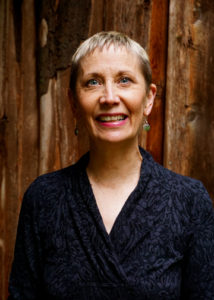I’m a collaborator and life-long learner by nature. As a dancer I loved the process of solving movement and choreography problems as a group. Through good fortune, I’ve managed to bring that spirit to my practice as a Guild Certified Feldenkrais Teacher ® .
I’ve learned that it sometimes takes a village to support the brave person who has elected to have joint replacement surgery. The path back home to healing, thriving and doing the things that bring joy can be challenging. I am thankful for the role I play in such a village of skilled professionals.
My fellow collaborators have separate office locations, but we function as if we’re in a clinic just down the hall from one another. We may operate in what appears to be contradictory paradigms (educational vs medical vs exercise and fitness) but we come together with a mission to solve the mysterious movement puzzles that often arise with joint replacement.
When my Physical Therapist friends refer someone for a series of Feldenkrais ® lessons they often describe my approach as fascinating, comprehensive, fun and magically guaranteed to put the finishing touches on their recovery. One therapist says, “It’s the icing on the cake”. I like that.
The referral may include a note about how the PT feels they are missing something. The person is stronger, more flexible and may hit all the measurements that allude to full recovery, but there’s still something ‘funky’ about their gait. They may be limping slightly or wincing during transitions from sitting to standing. Favoring one leg over the other.
The person may have new worries about balance issues or may fear that they have forever lost their confidence in descending stairs or kneeling to the ground for gardening, playing with their dog or working out.
Sometimes there’s frustration that the recovery process has hit a plateau. Fortunately for me, a plateau is not a problem. It’s a launching pad. I see it as an organic part of any living, learning process. It may be a sign of fatigue or boredom or simply a request for a well-earned rest. We tend to forget that the healing process is not linear.
New hands, new eyes and a pivot from exercise to movement exploration may be just the ticket. In the standard exercise paradigm, it’s easy to perpetuate a narrative that there’s a ‘good’ knee and a ‘bad’ knee. When we move to the first-person experience of shifting one’s weight or noticing how new movements of the chest and back contribute to feeling more connected to the ground, we change the story.
As a Feldenkrais Practitioner ®, I’m interested in the patterns of compensation that have accompanied the person through years of navigating life with chronic pain. The limp that the PT is observing may have everything or nothing to do with an in-the-moment experience of pain. It may be evidence of a well-worn path of habit. A nervous system glitch that says more about the past than the present.
One of my new referrals, who still had the shadow of a limp when walking was not in pain, but she described feeling that something was off. She noticed that her balance on her right leg had not improved much despite working on it with her trainer. She also reported that she still felt some trepidation when stepping off a curb. (She’d had right knee replacement and was well into her recovery.)
After watching her walk around my studio, I led her through a slow-motion process that I call “Walking the Wall”. I asked questions about what part of her foot touched the ground first and what she noticed as she rose on to her forward leg. I offered various options for where to begin the weight shift and she suddenly turned and said, “I don’t rise, I sink!” “My leg feels like a stick”. “It’s like dead wood”. “How did I not notice that before?”
Without getting too technical, I explained that the process of accommodating to a degenerative joint didn’t happen overnight. Over time, she developed structural changes and unconscious strategies for avoiding pain and moving as best she could.
There were two very common things at play here. One: She was still moving as if she needed to protect her knee at all costs by calling on a time-honored pattern of tilting her pelvis and pitching her torso forward. Two: Her new knee was still an outlying ‘other’ from her brain’s perspective. Not yet a welcome and embodied part of the whole.
As we explored more options for shifting on to her forward leg, she found that she in fact could rise (as she had on the other side) and squealed with delight. The capacity had been there all along. “Did I just have amnesia about how to do it?” Kind of. “Wow, I feel like my leg is coming back. I can balance better.” Excellent! Now let’s go to the table and see if we can wake up your mid back. And we did.
We had already observed that she held her head forward when standing and had begun to investigate how the position of her pelvis influenced that. On my table she could more clearly feel the rounding forward of her shoulders and the two big gaps of contact at her upper and lower spine. Her head now tilted backwards (chin away from chest) and her mid spine landed hard on the table.
When I added about three inches of foam to support her head in a more neutral alignment with the rest of her spine, she took a deep breath. I supported her knees and ankles with rollers as well and we began a conversation, verbally and through touch, to explore how to move within this new foundation.
With her breathing as my guide, I began to amplify the rounding of her mid and upper back by gently pressing on her breastbone and ribs. She instantly felt how that movement was connected to her head. I offered variations of tilting back (as was her bias) and tilting forward in the direction of her chest, including lifting her head with my other hand. With slow repetition, her face, neck and shoulders began to soften. As I placed my hands underneath what had been the big gaps, I could barely fit.
“Wow, how did you do that?” I told her that we did that. A simple explanation would be that I ‘took over the work’ that she was doing, so she could let it go. It was her nervous system’s way of saying thank you.
Our lesson continued with hands-on explorations of flexing and slightly rotating her spine with assistance from her crossed arms, bringing an elbow in the direction of her opposite hip, and lifting her shoulder to clarify the rotation of her chest – all in service to reveal that her mid back is designed to twist, turn and be mobile. It’s a necessary component of cross lateral movement in walking.
When we returned to the wall to practice the slow-motion weight shifting, she was stunned by the difference. She could feel the rise on her forward leg from the ground through her spine and into her head with a simple lift of her back heel. We had begun to uncover what was interfering with her stability and it wasn’t just her knee.
Over time, with improvements to her balancing and weight shifting abilities, I noticed a more confident stride. She was buoyant. I saw more spontaneous and expressive movements of her arms and chest. Not surprisingly, she began to describe how she felt more grounded physically and psychologically. Like body, like mind.
I’ve come to think of this phase of recovery as one of deep integration. It involves reclaiming embodied ownership of a limb that may have been a source of great pain for many years. So much so, that the sense of “other” is often revealed in how the person speaks of THE knee or hip, instead of MY knee or hip. I know we’re making progress when the person shifts into using the personal possessive. It’s a milestone.
I haven’t experienced joint replacement personally. I can only imagine how long it takes for those skillfully fitted pieces of titanium to feel at home and embedded in bone. Or for the person who’s sporting them to come to peace with all the newness while grieving the changes in physical capacity that can accompany surgery, illness or the inevitable march of time.
This process of embodied ownership is one of the crown jewels of the Feldenkrais Method ®. I witness the miracle of it every day in my practice and it’s the very thing that made me want to become a practitioner.
Dialing in to the intricate workings of the nervous system through our primary language of movement is so satisfying. Through hands-on and verbally guided explorations, I invite my clients to inhabit a world of new movement possibilities. There’s a call to curiosity and a suspension of knowing exactly what’s going to happen. And therein lies the magic. It’s the wonder of moving and paying attention. Simple and profound.
 About Becci:
About Becci:

